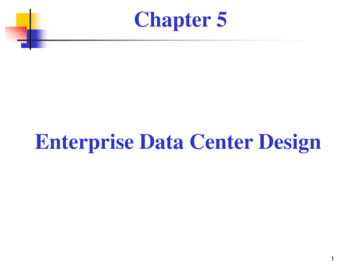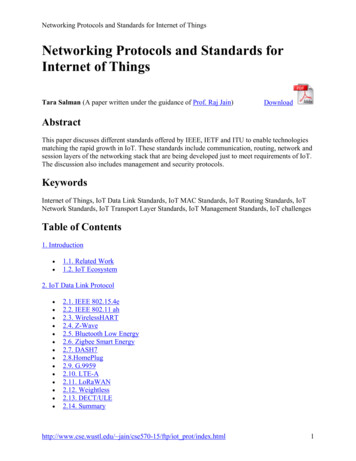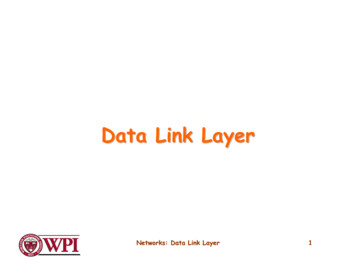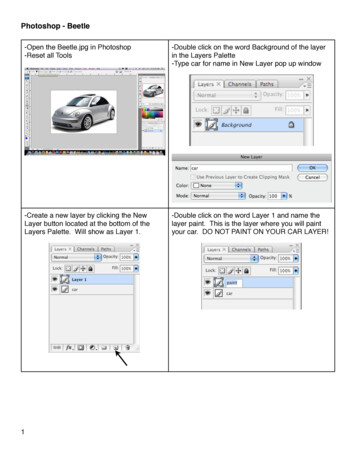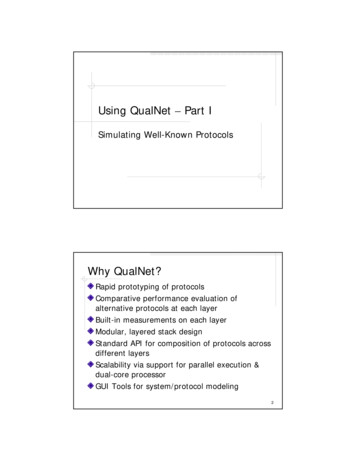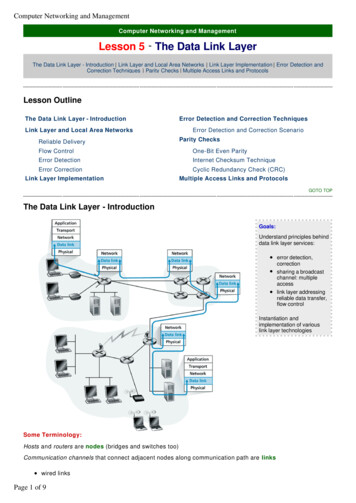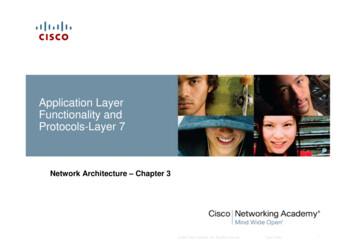
Transcription
Application LayerFunctionality andProtocols-Layer 7Network Architecture – Chapter 3 2007 Cisco Systems, Inc. All rights reserved.Cisco Public١
ObjectivesDefine the application layer as the source anddestination of data for communication acrossnetworks.Explain the role of protocols in supportingcommunication between server and clientprocesses.Describe the features, operation, and use ofwell-known TCP/IP application layer services(HTTP, DNS, SMTP). 2007 Cisco Systems, Inc. All rights reserved.Cisco Public٢
Applications – The Interface BetweenHuman and Data NetworksApplications provide the means for generating and receiving datathat can be transported on the network 2007 Cisco Systems, Inc. All rights reserved.Cisco Public٣
Most of us experience the Internet through the WorldWide Web, e-mail services, and file-sharingprograms. These applications, and many others,provide the human interface to the underlying network,enabling us to send and receive information. 2007 Cisco Systems, Inc. All rights reserved.Cisco Public٤
Applications – The Interface Between Human and Data NetworksApplication layer is the layer that provides the interface between theapplications we use to communicate and the underlying networkover which our messages are transmitted. 2007 Cisco Systems, Inc. All rights reserved.Cisco Public٥
Applications – The Interface BetweenHuman and Data Networks 2007 Cisco Systems, Inc. All rights reserved.Cisco Public٦
TCP/IP Application layer protocolsThese protocols specify the format and control informationnecessary for many of the common Internet communicationfunctions. Among these TCP/IP protocols are:Domain Name Service Protocol (DNS) is used to resolve Internetnames to IP addresses.Hypertext Transfer Protocol (HTTP) is used to transfer files thatmake up the Web pages of the World Wide Web.Simple Mail Transfer Protocol (SMTP) is used for the transfer ofmail messages and attachments.Telnet, a terminal emulation protocol, is used to provide remoteaccess to servers and networking devices. (SSH)File Transfer Protocol (FTP) is used for interactive file transferbetween systems. 2007 Cisco Systems, Inc. All rights reserved.Cisco Public٧
Domain Name System (DNS) - TCP/UDP Port 53Hypertext Transfer Protocol (HTTP) - TCP Port 80Simple Mail Transfer Protocol (SMTP) - TCP Port 25Post Office Protocol (POP) - TCP Port 110Telnet - TCP Port 23Dynamic Host Configuration Protocol - UDP Ports 67and 68File Transfer Protocol (FTP) - TCP Ports 20 and 21 2007 Cisco Systems, Inc. All rights reserved.Cisco Public٨
آ The functions associated with the Application layerprotocols enable our human network to interface withthe underlying data network. 2007 Cisco Systems, Inc. All rights reserved.Cisco Public٩
Within the Application layer, there are two forms ofsoftware programs or processes that provide access tothe network: applications and services. 2007 Cisco Systems, Inc. All rights reserved.Cisco Public١٠
1- Network-Aware ApplicationsApplications are the software programs used bypeople to communicate over the network. Some enduser applications are network-aware, meaning that theyimplement the Application layer protocols and are ableto communicate directly with the lower layers of theprotocol stack. E-mail clients and web browsers areexamples of these types of applications. 2007 Cisco Systems, Inc. All rights reserved.Cisco Public١١
2- Application layer ServicesOther programs may need the assistance of Applicationlayer services to use network resources, like filetransfer or network printer. These services are theprograms that interface with the network and preparethe data for transfer.Different types of data - whether it is text, graphics, orvideo - require different network services to ensure thatit is properly prepared for processing by the functionsoccurring at the lower layers of OSI model. 2007 Cisco Systems, Inc. All rights reserved.Cisco Public١٢
Protocols ام ا ا آ Each application or network service uses protocolswhich define the standards and data formats to beused. Without protocols, the data network would nothave a common way to format and direct data. 2007 Cisco Systems, Inc. All rights reserved.Cisco Public١٣
The Application layer relies on the functions of thelower layers in order to complete the communicationprocess. Within the Application layer, protocols specify:1- what messages are exchanged between the sourceand destination hosts,2- the syntax of the control commands,3- the type and format of the data being transmitted,4- and the appropriate methods for error notificationand recovery. 2007 Cisco Systems, Inc. All rights reserved.Cisco Public١٤
The Client/Server modelthe device requesting the information is called a clientandthe device responding to the request is called a server.Client and server processes are considered to be in theApplication layer. Advantages? 2007 Cisco Systems, Inc. All rights reserved.Cisco Public١٥
ServersIn a client/server network, the server runs a service, orprocess, sometimes called a server daemon. Like mostservices, daemons typically run in the background andare not under an end user's direct control.Daemons are described as "listening" for a requestfrom a client, because they are programmed to respondwhenever the server receives a request for the serviceprovided by the daemon. 2007 Cisco Systems, Inc. All rights reserved.Cisco Public١٦
Additionally, servers typically have multiple clientsrequesting information at the same time. For example,a Telnet server may have many clients requestingconnections to it. These individual client requests mustbe handled simultaneously and separately for thenetwork to succeed. The Application layer processesand services rely on support from lower layerfunctions to successfully manage the multipleconversations. 2007 Cisco Systems, Inc. All rights reserved.Cisco Public١٧
2007 Cisco Systems, Inc. All rights reserved.Cisco Public١٨
The Peer-to-Peer ModelPeer-to-peer networking involves two distinct forms:1- peer-to-peer network design and2- peer-to-peer applications (P2P). 2007 Cisco Systems, Inc. All rights reserved.Cisco Public١٩
Peer-to-Peer Networktwo or more computers are connected via a networkand can share resources (such as printers and files)without having a dedicated server. Every connectedend device (known as a peer) can function as either aserver or a client. One computer might assume the roleof server for one transaction while simultaneouslyserving as a client for another. The roles of client andserver are set on a per request basis.characteristics of peer-to-peer networks? 2007 Cisco Systems, Inc. All rights reserved.Cisco Public٢٠
Peer-to-Peer Applications propertiesallows a device to act as both a client and a serverwithin the same communication.In this model, every client is a server and every servera client. Both can initiate a communication and areconsidered equal in the communication process. (canbe used in client-server networks) 2007 Cisco Systems, Inc. All rights reserved.Cisco Public٢١
2007 Cisco Systems, Inc. All rights reserved.Cisco Public٢٢
2007 Cisco Systems, Inc. All rights reserved.Cisco Public٢٣
DNS Services and Protocol 2007 Cisco Systems, Inc. All rights reserved.Cisco Public٢٤
2007 Cisco Systems, Inc. All rights reserved.Cisco Public٢٥
2007 Cisco Systems, Inc. All rights reserved.Cisco Public٢٦
2007 Cisco Systems, Inc. All rights reserved.Cisco Public٢٧
2007 Cisco Systems, Inc. All rights reserved.Cisco Public٢٨
2007 Cisco Systems, Inc. All rights reserved.Cisco Public٢٩
WWW Service and HTTP Protocol 2007 Cisco Systems, Inc. All rights reserved.Cisco Public٣٠
2007 Cisco Systems, Inc. All rights reserved.Cisco Public٣١
2007 Cisco Systems, Inc. All rights reserved.Cisco Public٣٢
WWW Service and HTTP Protocol 2007 Cisco Systems, Inc. All rights reserved.Cisco Public٣٣
When a web address (or URL) is typed into a web browser, the web browserestablishes a connection to the web service running on the server using the HTTPprotocol. URLs (or Uniform Resource Locator) and URIs (Uniform ResourceIdentifier) are the names most people associate with web addresses.Web browsers are the client applications our computers use to connect to the WorldWide Web and access resources stored on a web server. As with most serverprocesses, the web server runs as a background service and makes different typesof files available.In order to access the content, web clients make connections to the server andrequest the desired resources. The server replies with the resources and, uponreceipt, the browser interprets the data and presents it to the user.Browsers can interpret and present many data types, such as plain text orHypertext Markup Language (HTML, the language in which web pages areconstructed). Other types of data, however, may require another service orprogram, typically referred to as plug-ins or add-ons. To help the browser determinewhat type of file it is receiving, the server specifies what kind of data the filecontains. 2007 Cisco Systems, Inc. All rights reserved.Cisco Public٣٤
To better understand how the web browser and web client interact, we canexamine how a web page is opened in a browser. For this example, wewill use the URL: http://www.cisco.com/web-server.htm.First, the browser interprets the three parts of the URL:1. http (the protocol or scheme)2. www.cisco.com (the server name)3. web-server.htm (the specific file name requested).The browser then checks with a name server to convert www.cisco.cominto a numeric address, which it uses to connect to the server. Using theHTTP protocol requirements, the browser sends a GET request to theserver and asks for the file web-server.htm. The server in turn sends theHTML code for this web page to the browser. Finally, the browserdeciphers the HTML code and formats the page for the browser window. 2007 Cisco Systems, Inc. All rights reserved.Cisco Public٣٥
For secure communication across the Internet, theHTTP Secure (HTTPS) protocol is used for accessingor posting web server information. HTTPS can useauthentication and encryption to secure data as ittravels between the client and server. 2007 Cisco Systems, Inc. All rights reserved.Cisco Public٣٦
E-mail Services and SMTP/POP Protocols 2007 Cisco Systems, Inc. All rights reserved.Cisco Public٣٧
E-mail Services and SMTP/POP ProtocolsE-mail, the most popular network service. Yet to run on a computeror other end device, e-mail requires several applications andservices. Two example Application layer protocols are Post OfficeProtocol (POP) and Simple Mail Transfer Protocol (SMTP). As withHTTP, these protocols define client/server processes.When people compose e-mail messages, they typically use anapplication called a Mail User Agent (MUA), or e-mail client. TheMUA allows messages to be sent and places received messagesinto the client's mailbox, both of which are distinct processes.In order to receive e-mail messages from an e-mail server, the email client can use POP. Sending e-mail from either a client or aserver uses message formats and command strings defined by theSMTP protocol. Usually an e-mail client provides the functionalityof both protocols within one application. 2007 Cisco Systems, Inc. All rights reserved.Cisco Public٣٨
2007 Cisco Systems, Inc. All rights reserved.Cisco Public٣٩
E-mail Server Processes - MTA and MDAThe e-mail server operates two separate processes:Mail Transfer Agent (MTA)Mail Delivery Agent (MDA)The Mail Transfer Agent (MTA) process is used to forward e-mail.The MTA receives messages from the MUA or from another MTA onanother e-mail server. Based on the message header, it determineshow a message has to be forwarded to reach its destination. If themail is addressed to a user whose mailbox is on the local server, themail is passed to the MDA. If the mail is for a user not on the localserver, the MTA routes the e-mail to the MTA on the appropriateserver. 2007 Cisco Systems, Inc. All rights reserved.Cisco Public٤٠
2007 Cisco Systems, Inc. All rights reserved.Cisco Public٤١
The Mail Delivery Agent (MDA) accepts a piece of email from a Mail Transfer Agent (MTA) and performsthe actual delivery. The MDA receives all the inboundmail from the MTA and places it into the appropriateusers' mailboxes. The MDA can also resolve finaldelivery issues, such as virus scanning, spam filtering,and return-receipt handling. 2007 Cisco Systems, Inc. All rights reserved.Cisco Public٤٢
Home WorksFile Transfer Protocol (FTP)The Dynamic Host Configuration Protocol (DHCP)The Server Message Block (SMB) 2007 Cisco Systems, Inc. All rights reserved.Cisco Public٤٣
A small home network has been installed tointerconnect three computers together for gaming andfile sharing. (Application Model?) 2007 Cisco Systems, Inc. All rights reserved.Cisco Public٤٤
Chapter Quiz 2007 Cisco Systems, Inc. All rights reserved.Cisco Public٤٥
1.Which three layers of the O S I model make up theApplication Layer of the TCP/IP model? (Choosethree.)A.data pplication 2007 Cisco Systems, Inc. All rights reserved.Cisco Public٤٦
2.What protocol is used to transfer web pages fromserver to client?A.HTMLB.SMTPC.HTTPD.SSHE.TelnetF.POP 2007 Cisco Systems, Inc. All rights reserved.Cisco Public٤٧
4.Which protocols use authentication and encryption tosecure data traveling between the client and server?(Choose two.)A.HTTPB.DNSC.HTTPSD.SMTPE.SSH 2007 Cisco Systems, Inc. All rights reserved.Cisco Public٤٨
8.A network administrator is troubleshooting failedaccess to www.cisco.com. Typing the IP address of theweb server into the browser successfully brings up theweb page. What Application Layer protocol isresponsible for the failure?A.DHCPB.DNSC.CDPD.HTTPE.HTTPSF.SSL 2007 Cisco Systems, Inc. All rights reserved.Cisco Public٤٩
2007 Cisco Systems, Inc. All rights reserved.Cisco Public٥٠
E-mail Services and SMTP/POP Protocols E-mail, the most popular network service. Yet to run on a computer or other end device, e-mail requires several applications and services. Two example Application layer protocols are Post Office Protocol (POP) and Simple Mail Transfer Protocol (SMTP). As with HTTP, these protocols define client/server .
